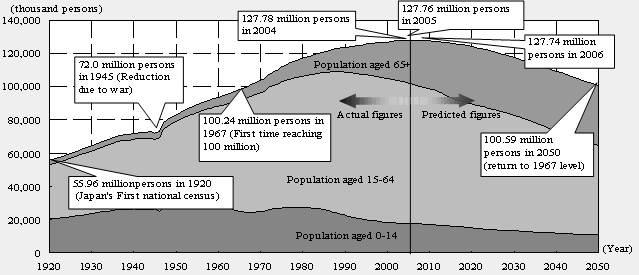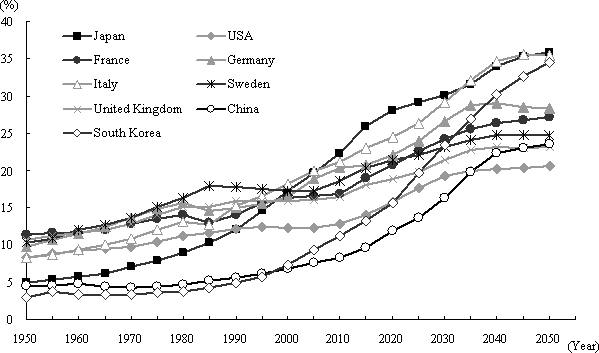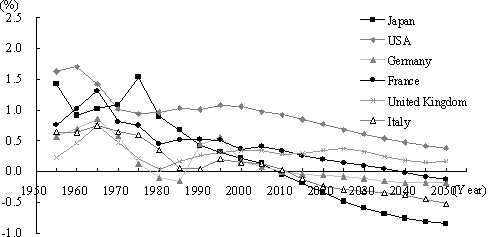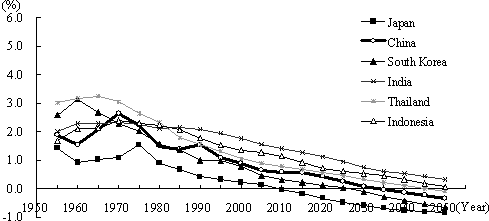1.1 Current Status of an Aging Society with Fewer Children and Challenges for Science and Technology
1.1.1 Current Status and Predictions for an Aging Society with Fewer Children
Summary
The population in Japan switched to a declining trend in 2005, two
years earlier than projected, due to the effects of an aging society with fewer
children. It is predicted that this declining trend will continue for the long
term in the future.
For the world as a whole, the population will continue
to grow in the future, but many developed nations and various countries in Asia
are also expected to make the transition to declining populations in the near
future. Japan will face the issues of declining population and the aging of
society and decrease in the number of children before these other countries.
●Start of a society with a declining population
According to the 2005 population statistics and annual projections
released in December 2005 it was projected that there would be 1,067,000 births
and 1,077,000 deaths in Japan that year, a difference of 10,000 people due to
"natural attrition".
Furthermore, according to the Population
Census (preliminary report), the projected population on October 1, 2005 was
127.76 million, a decrease of 20,000 from the projected population of 127.78
million for October 1, 2004.
In 2005 the total population of Japan
dropped below the level of the previous year for the first time since World
War Ⅱ. This start of a population decline is two years sooner than the 2007 date
predicted in the National Institute of Population and Social Security Research
January 2002 projections (intermediate forecast) (Figure 1-1-1).

Figure 1-1-1 Changes in the population structure in Japan
Note:
Between 1941 and 1943 the breakdown of the population into the
three age groups was supplemented from the values for 1940 and 1944. The data
from 1946 through 1971 does not include Okinawa. In the total numbers for the
Population Census the people for whom age was not known were distributed proportionally
among the age groups.
Source:
Through 2005, numbers are taken from the Ministry of Internal
Affairs and Communications, Statistics Bureau "Population Census,"
"October 1 Population Estimates." For 2006 and after, values are based
on the National Institute of Population and Social Security Research, "Population
Projections for Japan (January 2002 Projections)" and the Cabinet Office
"White Paper on Birthrate-Declining Society 2004" (December 2004)
●Progress of aging society and decrease in the number of children
A direct cause of population decline is a decrease in the number of
births and an increased number of deaths according to aging.
Looking
at the number of births, there has been a decreasing trend since Japan's second
baby boom in 1974. The total fertility rate (Note 1) reached an all-time low
of 1.29 in 2004, and the decrease in the number of children is progressing more
noticeably than in Europe and the USA.
The proportion of elderly people
indicated by the percentage of the population aged 65 years or over, rose rapidly
after 1970 with the increase in life expectancy and decrease in number of children.
This proportion surpassed 14%, the level regarded to constitute an "elderly
society," in 1994. In October 2004 the rate reached 19.5%, with Japan's
proportion of elderly people surpassing that of other developed nations.
The
aging of society in Japan is characterized by its high proportion of elderly
people and the extremely rapid aging rate compared to other countries. Based
on comparison of Japan's expected future proportion of elderly people with that
of other countries, based on estimates by the United Nations, it is projected
that the aging of society in Japan will continue at a rapid pace that exceeds
that of other countries (Figure 1-1-2).
Note 1:
The sum of the age-specific fertility rates for females
between the ages of 15 and 49 for that year. It is equivalent to the number
of children that one woman would bear over her lifetime if she were to experience
the current age-specific fertility rates.

Figure 1-1-2 Percentage of population aged 65 and older in various countries
Source:
United Nations, World Population Prospects: The 2004 Revision
● Population Projections for Japan and the World
According to the projections of the National Institute of Population
and Social Security Research (January 2002 median projection), the population
of Japan is expected to continue to decline and become about 100.59 million
in 2050. At that time, the percentage of the population aged 65 or older is
projected to be 35.7%, while the percentage of the population aged 14 and younger
will be 10.8%, so there will be 3 times as many elderly people as children,
creating an elderly society with extremely few children. (Figure 1-1-1)
According
to the United Nations projections in 2004 the total world population is expected
to continue to increase, although the rate of increase will decline. In major
developed nations it is predicted that the populations will begin to decrease,
in the 2010s for Italy and Germany, and in the 2040s for France. Furthermore,
in Asia it is projected that South Korea will experience a population decline
that is even quicker than that in Japan, while China in the 2030s and Thailand
in the 2040s are expected to start facing population declines. Japan is facing
this situation earlier than these other countries and is now confronting the
problems of a declining population and an aging society with fewer children
(Figure 1-1-3).
(1) Main developed nations

(2) Asia

Figure 1-1-3 Projected annual average population expansion for main developed nations and Asia
Note:
For countries other than Japan, the numbers here may differ
from the country's own projections
Source:
United Nations, World Population Prospects: The 2004 Revision
For Japan, numbers through 2005 are from the Statistics Bureau "Population
Census," "October 1 Population Estimates," for 2010 and later,
based on the National Institute of Population and Social Security Research,
"Population Projections for Japan (January 2002 Projections)".
Contacts
Research and Coordination Division, Science and Technology Policy Bureau
(Research and Coordination Division, Science and Technology Policy Bureau)




